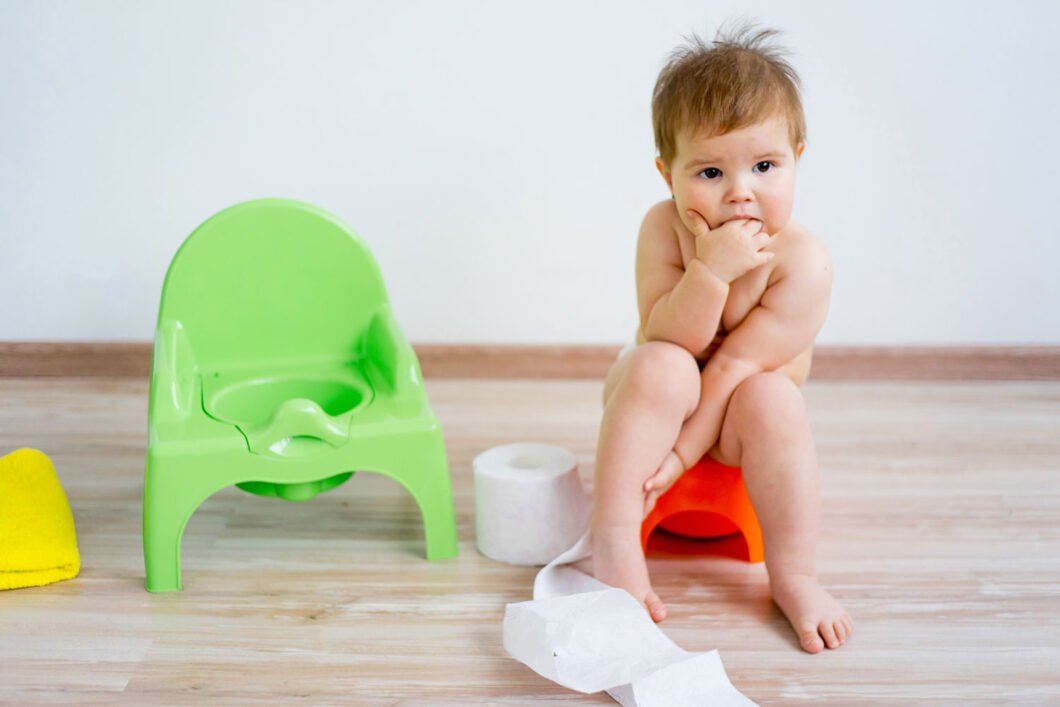Potty training, also known as toilet training or toilet learning, is a significant milestone in a child’s development, marking the transition from diapers to using the toilet independently. While the exact age at which children start potty training can vary widely, most children typically begin between the ages of 18 months and 3 years old. However, it’s essential to remember that every child is different, and readiness for potty training is more about developmental readiness than a specific age.

Several signs indicate that a child may be ready to start potty training:
- Showing Interest: Children who are ready for potty training may show interest in the bathroom habits of adults or older siblings. They may ask questions about using the toilet or express curiosity about the toilet.
- Ability to Follow Simple Instructions: Successful potty training often depends on a child’s ability to understand and follow simple instructions. Children who can follow directions and communicate their needs effectively may be ready to begin toilet training.
- Increased Independence: As children grow, they often become more independent in various aspects of their daily routine. If your child shows a desire to do things independently, such as dressing themselves or feeding, they may also be ready for potty training.
- Staying Dry for Longer Periods: Another sign of readiness for potty training is when a child’s diaper stays dry for more extended periods, indicating that they have better control over their bladder.
- Expressing Discomfort with Diapers: Some children may begin to express discomfort with wearing diapers or may request to have their diapers changed immediately after soiling them. This discomfort could indicate readiness to transition to using the toilet.
Once you determine that your child is showing signs of readiness for potty training, it’s essential to approach the process with patience, encouragement, and positivity. Here are some tips for successful potty training:
- Establish a Routine: Create a regular potty schedule by encouraging your child to sit on the potty at consistent times throughout the day, such as after meals or upon waking up.
- Use Positive Reinforcement: Offer praise and encouragement when your child successfully uses the potty, regardless of whether they actually produce any results. Positive reinforcement helps motivate children and boosts their confidence.
- Make It Fun: Turn potty time into a positive and enjoyable experience by incorporating fun activities or rewards, such as reading a favorite book together or giving them a sticker for their accomplishments.
- Be Patient and Understanding: Understand that accidents are a natural part of the learning process and avoid punishing or shaming your child for accidents. Instead, offer reassurance and support as they navigate this new skill.
- Lead by Example: Allow your child to observe you using the toilet and explain what you’re doing in simple terms. Modeling proper bathroom behavior can help reinforce the concept for your child.
It’s important to keep in mind that potty training is a gradual process, and every child will progress at their own pace. Some children may master toilet training quickly, while others may take longer to feel comfortable using the toilet independently. By being patient, supportive, and consistent, you can help make the potty training experience a positive and successful one for your child.
What are the key points for potty training in babies?
Potty training, a significant milestone in a child’s development, marks the transition from diapers to using the toilet independently. While this process can be challenging, understanding some key points and strategies can make it smoother for both parents and children.

- Wait for Signs of Readiness: One of the essential factors in successful potty training is waiting until your child shows signs of readiness. These signs may include expressing interest in the toilet, staying dry for more extended periods, and showing independence in other areas of daily life.
- Establish a Routine: Consistency is key when it comes to potty training. Create a regular schedule for potty breaks, such as after meals or upon waking up. Encourage your child to sit on the potty during these times, even if they don’t need to go.
- Use Positive Reinforcement: Praise and encouragement go a long way in motivating children during potty training. Celebrate their successes, no matter how small, with words of encouragement, high-fives, or small rewards like stickers.
- Make It Fun: Turn potty time into a positive and enjoyable experience. Consider using a fun potty chair or reading books about using the toilet to make the process more engaging for your child.
- Lead by Example: Children often learn by observing others, so let them see you or older siblings using the toilet. Explain what you’re doing in simple terms and encourage them to mimic your behavior.
- Be Patient and Understanding: Accidents are a normal part of the learning process, so be patient and understanding when they occur. Avoid scolding or shaming your child for accidents, as this can create anxiety and hinder progress.
- Dress for Success: Dress your child in clothing that is easy to remove, such as pants with elastic waistbands, to facilitate independent trips to the potty.
- Offer Independence: Encourage your child to be independent in the bathroom by allowing them to flush the toilet, wash their hands, and pull up their pants on their own.
- Stay Consistent: Consistency is crucial during potty training. Stick to your established routine and remain consistent with your approach, even when progress is slow.
- Be Prepared for Setbacks: Potty training is rarely a linear process, and setbacks are common. Be prepared for regressions and setbacks along the way, and approach them with patience and understanding.
Remember that every child is unique, and the potty training process may unfold differently for each one. Stay positive, patient, and supportive, and celebrate each step forward in your child’s potty training journey. With time, patience, and consistency, your child will eventually become comfortable using the toilet independently.

